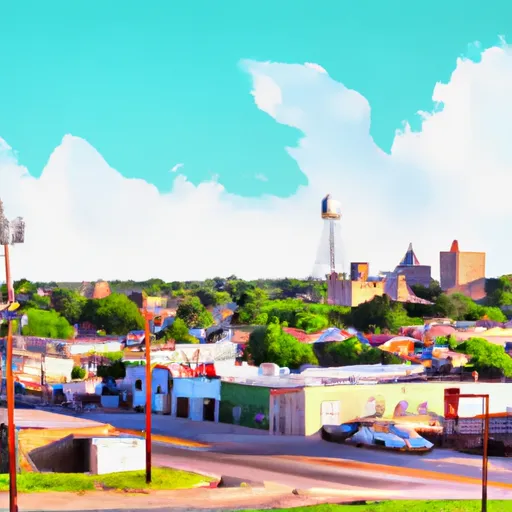-
 Snoflo Premium
Snoflo Premium
Get unlimited access to all our content
With no Ad interruptions! - Start Your Free Trial Login with existing account
Kress
Eden Index
Climate
9.5
•
Recreation
2.5
•
Community
1.4
•
Safeguard
5.0/10

Kress, Texas is a small town located in Swisher County in the northern part of the state. The climate in Kress is considered to be a semi-arid type, characterized by hot summers and mild winters. The area experiences low precipitation, with an average annual rainfall of around 20 inches. Summers are usually hot and dry, with temperatures often exceeding 90°F, while winters are milder with temperatures ranging from 30°F to 60°F.
In terms of hydrology constituents, Kress is part of the Ogallala Aquifer region, which provides a crucial water source for agriculture and other industries in the area. The town relies heavily on groundwater for its water supply.
While Kress may not offer a wide range of outdoor recreation opportunities within its immediate vicinity, it is surrounded by the beautiful Texas Panhandle region. Outdoor enthusiasts can explore the nearby Caprock Canyons State Park, located about 70 miles to the northwest. This park offers various outdoor activities such as hiking, camping, mountain biking, and horseback riding. Visitors can also enjoy fishing and boating at Buffalo Lake, situated approximately 30 miles to the northeast of Kress.
What is the Eden Index?
The Snoflo Eden Index serves as a comprehensive rating system for regions, evaluating their desirability through a holistic assessment of climate health, outdoor recreation opportunities, and natural disaster risk, acknowledging the profound impact of these factors on livability and well-being.
Climate Health Indicator (CHI): 9.5
Kress receives approximately
496mm of rain per year,
with humidity levels near 63%
and air temperatures averaging around
15°C.
Kress has a plant hardyness factor of
7, meaning
plants and agriculture in this region tend to thrive during the non-winter months.
By considering the ideal temperature range, reliable water supplies, clean air, and stable seasonal rain or snowpacks, the Climate Health Indicator (CHI) underscores the significance of a healthy climate as the foundation for quality living.
A healthy climate is paramount for ensuring a high quality of life and livability in a region, fostering both physical well-being and environmental harmony. This can be characterized by ideal temperatures, reliable access to water supplies, clean air, and consistent seasonal rain or snowpacks.
Weather Forecast
Streamflow Conditions
Brazos Headwaters
Area Rivers
Brazos Headwaters
Snowpack Depths
Brazos Headwaters
Reservoir Storage Capacity
Brazos Headwaters
Groundwater Levels
Recreational Opportunity Index (ROI): 2.5
The Recreational Opportunity Index (ROI) recognizes the value of outdoor recreational options, such as parks, hiking trails, camping sites, and fishing spots, while acknowledging that climate plays a pivotal role in ensuring the comfort and consistency of these experiences.
Access to outdoor recreational opportunities, encompassing activities such as parks, hiking, camping, and fishing, is crucial for overall well-being, and the climate plays a pivotal role in enabling and enhancing these experiences, ensuring that individuals can engage in nature-based activities comfortably and consistently.
Camping Areas
| Campground | Campsites | Reservations | Toilets | Showers | Elevation |
|---|---|---|---|---|---|
| Slaton City Park | 5 | 3,084 ft | |||
| Ollie Liner RV Park | 44 | 3,365 ft | |||
| Buffalo Springs Lake | None | 3,022 ft |
Nearby Ski Areas
Catastrophe Safeguard Index (CSI):
The Catastrophe Safeguard Index (CSI) recognizes that natural disaster risk, encompassing floods, fires, hurricanes, and tornadoes, can drastically affect safety and the overall appeal of an area.
The level of natural disaster risk in a region significantly affects safety and the overall livability, with climate change amplifying these risks by potentially increasing the frequency and intensity of events like floods, fires, hurricanes, and tornadoes, thereby posing substantial challenges to community resilience and well-being.
Community Resilience Indicator (CRI): 1.4
The Community Resilience Indicator (CRI) recognizes that education, healthcare, and socioeconomics are crucial to the well-being of a region. The CRI acknowledges the profound impact of these elements on residents' overall quality of life. By evaluating educational resources, healthcare accessibility, and economic inclusivity, the index captures the essential aspects that contribute to a thriving community, fostering resident satisfaction, equity, and social cohesion.

